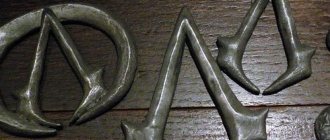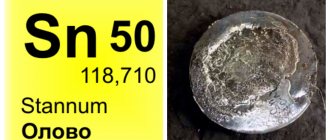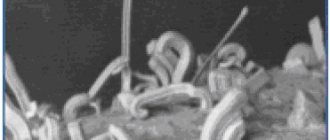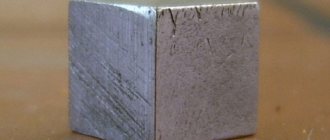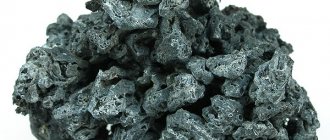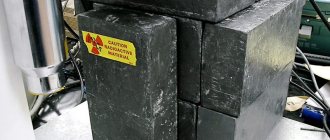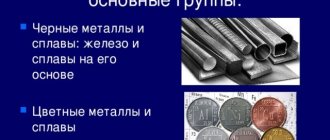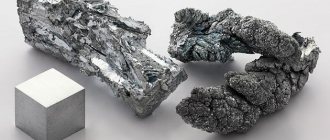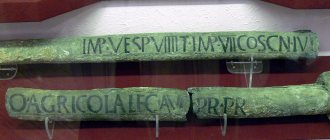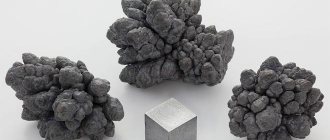History of discovery
Before talking about the production of the alloy, you need to understand where its main components came from. Based on archaeological finds, historians have established that lead first appeared 6 thousand years ago. It was contained in silver ores.
The noble metal was used to make jewelry, dishes, and cutlery. Lead was considered a waste product and therefore was not used. However, gradually people noticed the properties of this material. Today it is used in production:
- alloys;
- batteries;
- structures protecting against radioactive radiation;
- coloring compositions, solders for radio electronics;
- protective sheath for wires.
This material is used in the automotive industry.
Tin appeared about 3500 years ago. It was originally used to make cutlery. In modern industry, this material is used to create cans. This began in 1810, when people learned to store food using metal containers. Tin is used in the manufacture of radiators for cars and bearings.
Tin is often used to make parts for industrial equipment. This is due to its increased hardness and strength. Compounds of this metal with lead are used to create bearings, since the mixture is considered wear-resistant.
How to distinguish lead and silver?
Silver jewelry has been popular since ancient times, being a more affordable alternative to gold. Therefore, many try to pass off other metals as silver, including lead. In most cases there is no particular problem in distinguishing them from each other, but beginners in this matter may have difficulties. So here are a few obvious differences you need to know.
Silver has a silvery-white color, with almost 100% light reflectance. Over time, this metal can darken, which is a natural reaction (silver becomes coated with sulfide). If it is real silver, then you can clean it with a special cream or toothpaste - you won’t be able to do this with lead, which also darkens.
It looks like silver, but has a bluish tint. Another simple way to check is with boiling water. You need to immerse the silver and lead product in boiling water for a few seconds and then remove it. Silver will get quite hot, but lead will not because it has low thermal conductivity.
Lead itself is a soft metal, so it can be easily bent (silver is used to make jewelry, so it has a higher density). At the same time, silver does not leave dark marks on the paper, unlike this metal.
We have experienced employees who can easily distinguish one non-ferrous metal from another. If additional analysis is needed, the scrap is sent to the laboratory. Therefore, if you have accumulated a certain amount of non-ferrous scrap metal and you cannot determine its type, then contact our collection points, where they will help you with this issue. We always adequately assess the amount of impurities in scrap, so we offer high prices when purchasing.
Composition and structure
Compounds often contain not only two main components, but also alloying additives. The main one is antimony. The compound may contain up to 15% of this substance. Other alloying additives are silver, cadmium and bismuth. Silver and antimony act in the same way. They are added when it is necessary to increase the melting temperature of the material. If it is necessary to make the mixture less refractory, it is saturated with bismuth and cadmium.
When it is necessary to create a wear-resistant material that will withstand constant friction, the mixture is supplemented with copper. Due to the variety of alloying additives that can be used in the production of tin and lead alloys, the compounds are used in various industrial areas.
Melting alloy
Properties and markings
Finished alloys based on tin and lead have a number of properties that make the compound unique:
- Melting point - up to 500 degrees Celsius, depending on the percentage of alloying additives.
- High wear resistance.
- Oxidation resistance is higher than that of pure materials.
There are two types of lead compounds: babbitts and solders. The first ones are designated by the letter “B”. Next, the letters of the alloying additives, the percentage of the main substance, and the number of additional components are indicated.
Tinning process.
Tinning (tin plating) is the process of applying a thin layer of tin or an alloy of tin with lead, bismuth, antimony, zinc, copper, nickel, as well as more exotic indium and gallium, to the surface of products.
You can tin copper, brass, bronze, carbon and stainless steel, aluminum and its alloys, titanium, ZAM.
Potential Sn0/Sn2+ = -0.136 V, Sn0/Sn4+ = +0.015 V, therefore, tin is more electronegative than copper and more electropositive than all other traditional bases. For this reason, tin-based coatings can electrochemically (anodically) protect only copper from corrosion. For other materials, tin will be the cathode and will provide protection only if there are no pores, chips or through scratches.
In general, tin coatings provide good screwability of threaded connections, solderability, and tightness of assemblies. Tin coating is a preparatory operation before filling bearings.
Tin coatings are characterized by good adhesion to the base metal, high elasticity, resistance to sulfur compounds and to tropical climates.
2.1 Tinning with pure tin.
The main area of application for pure tin coatings is the food industry. Tin forms complexes with organic acids in a sealed environment, as a result of which its potential shifts to the positive region and it becomes an anode with respect to iron. This property, as well as the almost complete harmlessness of simple tin compounds, made it possible to use it to protect the internal surfaces of cans. In the 20th century, about 50% of the mined tin was used for the production of white (tinned) tin. These same properties of tin have made it possible to use coatings based on it for anti-corrosion protection of a wide range of food equipment.
In electrical engineering, tin coatings are used to protect copper cables from the destructive effects of sulfur contained in rubber insulation; for soldering contacts; to create an easily break-in electrically conductive layer between the rubbing surfaces. Tin coatings are plastic and withstand mechanical loads (rolling, stamping, drawing).
Electrochemical tin coatings are easy to obtain, which is ensured, in particular, by the high current efficiency of tinning electrolytes, but they have a number of problematic properties:
• In the case of long-term storage, the growth of thread-like crystalline formations is observed on their surface, which grow in length up to 3-5 mm with a thickness of several microns. These formations, called “whiskers,” can cause a short circuit inside electrical and radio equipment, and, accordingly, lead to its failure. The exact cause of such phenomena has not yet been established. It has been observed that the material on which the coating is deposited influences the rate of whisker formation. So, in particular, on a tin coating applied directly to brass, without a technological sublayer, thread-like crystals appear more often and grow faster than on a steel base.
• There is a theory that under the influence of impurities in the coating, internal compressive stresses of a specific nature arise, which is the main reason for the growth of threadlike whiskers. Impurities in the coating can be mechanical inclusions (particles of a foreign solid phase), have a diffusion nature (diffusion from the base metal into the coating), and can also be included in the deposit during coprecipitation with the base coating. Also, the cause of whisker growth is considered to be the presence of stress in the base metal.
• “Tin plague” - transition from a compact allotropic modification to amorphous tin. When the temperature drops below +13.2ºС, a phase transition occurs from compact white tin to powdery gray tin. The process proceeds intensively at temperatures below -30 °C and is accompanied by an increase in the specific volume of the metal, as a result of which the coating is completely destroyed.
• One of the main problems with pure tin is that it has a very short life as a solder plating. Theoretically, this period is two weeks. In production practice, it has been established that after 2-3 days of storage, soldering becomes almost impossible. This is due to the fact that pure tin coating is very porous and contains a large number of impurities. The solderability of a tinned surface may also decrease due to the formation of intermetallic compounds such as Cu3Sn, Cu6Sn5 at the copper-tin interface, which lose their ductility even at a small thickness (3 µm).
To preserve the solderability properties and reduce the porosity of the coating, the tinned surface must be melted. Melting is carried out by immersion in glycerin at 230 ºС, which is very energy-consuming and increases the final cost of the coating.
2.2 Tin plating with tin-copper alloy (bronzing).
Features of the functional properties and appearance of the tin-copper alloy are determined by the percentage of components. With a content of 2 to 3% tin, the coating has a copper-red color; when the percentage of tin increases to 15-20, the coating becomes golden yellow (yellow bronze), and at 35% tin it acquires a silver-white color, close to tin ( white bronze).
Yellow bronze coatings on steel exhibit high corrosion resistance in cold and boiling tap water. Yellow bronze has low porosity and can be used both as an independent coating and as a sublayer, for example, before chrome plating.
Coatings with a high tin content (more than 35%) have high porosity and cannot be used for protection in aggressive corrosive environments. White bronze has a very decorative appearance and is used as a replacement for nickel plating. Also interesting are coatings with a tin content of 45% or more - they can be painted black by anodic oxidation.
The electrical properties of the coating play a major role: the resistivity of electrolytic bronze containing 25% Cu and 75% Sn is 0.189 Ohm*mm2 /m, and that of 60% Cu and 40% Sn is 0.248 Ohm*mm2 /m. As is known, the resistivity of silver is 0.015 Ohm*mm2 /m, Cu is 0.017 Ohm*mm2 /m, and Sn is 0.143 Ohm*mm2 /m. The data presented indicate that white bronze coating is inferior in electrical properties to silver and copper coatings. However, when working in an environment containing sulfur compounds, the transient resistance of bronze coatings is more stable than silver ones. The value of the electrical resistance of the alloy increases synchronously with the increase in its hardness, the maximum corresponds to a Sn content of 40-45%.
2.3 Tin plating with tin-lead alloy.
Due to its chemical resistance, the Sn-Pb alloy is actively used as a protective anti-corrosion coating.
The alloy is low-melting, has a high density and low mechanical strength, and can be used to ensure sintering and as an anti-friction coating.
The coating ensures the uniformity of the soldered seam, eliminating the formation of heterogeneous systems with a complex structure that cause brittleness of the joint.
The average electrical conductivity of tin-lead coatings is comparable to that of gold coatings.
A positive property of the alloy should also be considered to ensure the constancy of the contact resistance when changing contact pressures.
Lead-tin alloy coatings containing only 5% tin have been found to provide significantly better corrosion protection than lead coatings in marine environments. Alloys with a 50/50 Sn-Pb content exhibit the greatest chemical resistance. The best antifriction properties are provided by an alloy with a composition of 8-12% Sn. Such coatings also act as a lubricant when stamping parts from sheet steel.
The use of POS-60 coating (tin 60%, lead 40%) allows you to intensify the soldering process by reducing the melting temperature of the alloy to 183 ºС
2.4 Tin plating with tin-zinc alloy.
Sn-Zn alloys have higher protective properties under atmospheric corrosion conditions compared to pure zinc. Its operation is allowed at high humidity and significant temperature fluctuations. An alloy containing 20-25% zinc has the best corrosion resistance. It is electrochemically anodic in relation to steel, and its porosity, compared to pure tin, is significantly lower. When the zinc content in the alloy increases to 50%, the corrosion resistance approaches that of pure zinc coating. When the alloy contains 10% zinc or less, the coating becomes cathodic in nature with respect to steel and ceases to protect it electrochemically.
An alloy containing 20% zinc is easy to solder and is solderable longer than zinc. It is also easy to polish.
2.5 Tin plating with tin-nickel alloy.
Coating with tin-nickel alloys is recommended to impart solderability to the surface of copper and steel parts with acid fluxes while protecting them from corrosion. Also, coating with an alloy containing 35-40% nickel can be used instead of chrome coatings. The microhardness of the alloy deposits is in the range of 4000-6000 MPa, the wear resistance is several times higher than the wear resistance of nickel coating.
The coating has high decorative characteristics and, due to its low porosity, can be used with one copper sublayer, without intermediate nickel plating. Subject to certain electrolysis conditions, the coating can be obtained shiny directly from the bath, without the use of shine-forming additives. The alloy can be used instead of tinning when higher mechanical properties than tin plating are required.
It is very advisable to use a tin-nickel alloy for parts to be pressed into plastics.
Electrolytic alloy Sn-Ni (65% Sn) is an intermetallic compound, stable up to 300 ºС. This coating is not recommended for use on parts that are subject to repeated bending or act as springs, as it is prone to peeling and cracking due to high internal stresses.
Porosity tests have shown that steel samples coated with a Sn-Ni alloy 15 µm thick with a copper sublayer 20 µm thick have virtually no pores and have high corrosion resistance in a salt fog environment with alternating heating. In addition, it was found that the coating retains solderability for several months, corresponding to a freshly deposited coating. After two years of storage, the solder strength of the tin-nickel coating decreased by 20%, and that of fused tin by 60%
2.6 Tin plating with tin-bismuth alloy.
Tin-bismuth coating has all the advantages of pure tin, but also has a number of advantages over it. Bismuth in the coating prevents the allotropic transition of tin from white to gray, allows you to maintain solderability for up to a year, eliminates the growth of “whiskers,” and increases corrosion resistance. The coating exhibits the best solderability with a low bismuth content in the alloy - from 0.5 to 2%. Alloys of tin and bismuth form eutectic-type systems, and with a bismuth content of up to 5%, the formation of a stable solid solution is expected at temperatures up to 231.8 °C.
2.7 Tin plating with tin-antimony alloy.
The tin-antimony alloy (5-10% Sb) is identical in properties to tin-bismuth. Tin-antimony thermal alloys with an antimony content of up to 0.5% are not susceptible to the “tin plague”. The main advantage of the tin-antimony alloy is that it does not contain highly toxic elements such as bismuth or lead, but this does not impair its performance properties.
2.8 Tin alloys, rarely used in electroplating.
2.8.1 Cadmium-tin alloy.
Cadmium-tin alloys are a simple eutectic mixture.
Alloys containing 25% tin and 75% cadmium exhibit high protective properties in salt fog environments. There is evidence that cadmium-tin coatings (40-60% cadmium) can be passivated in a chromate solution with increased resistance to corrosion. Tests have shown that cadmium-tin coatings in an environment of heat and moisture are not inferior in corrosion resistance to coatings with Cd-Zn and Sn-Zn alloys. During tests, dense, non-erasing films of corrosion products are formed on the surface of the Cd-Sn coating, increasing their protective properties.
Of particular interest is the use of cadmium-tin alloy for corrosion protection of steel parts of aircraft equipment. The corrosive environment, in this case, is especially aggressive due to sudden temperature changes, moisture condensation on the surface of parts, as well as exposure to volatile plastic products, insulating materials, lubricating oils and fuels.
2.8.2 Copper-zinc-tin alloy.
In practice, Cu-Zn-Sn electrolytic alloy is difficult to control by percentage of components. The alloy can be obtained in various colors: from silver-steel to golden. The color of the precipitate can be varied by the temperature of the solution and by adjusting the current density.
Alloys of this composition retain their ability to be soldered for a long time and have fairly high hardness and wear resistance. In industry they can be used to protect threaded and precision parts from corrosion, for which a large coating thickness is not allowed. Golden-colored coatings can be used to decoratively imitate gold. During the study, copper-zinc-tin and copper-cadmium-tin alloys were tested in a tropical humid climate. Tests have shown that these three-component alloys protect steel less well than coatings with Zn-Cd, Sn-Zn and Sn-Cd dual alloys with appropriate passivation.
2.8.3 Lead-tin-zinc alloy.
The introduction of a third component into the lead-tin alloy makes it possible to further improve the protective, antifriction and other functional properties of coatings. To reduce tin consumption when coating parts of internal combustion engines, it is proposed to use a three-component alloy: 91-93% lead; 6-8% tin; 0.5-5% zinc. The use of lead and zinc coatings for such parts is not effective due to their low corrosion resistance to organic compounds and elevated temperatures. Under these conditions, tin and cadmium coatings reliably protect parts from corrosion, but Sn and Cd are among the scarce and expensive metals.
The Pb-Sn-Zn coating has the highest corrosion resistance with a zinc content of no more than 1%. In this case, the protective properties of the coating in high temperature environments and organic compounds are much higher than those of tin and cadmium coatings. In addition, the pronounced protective properties of the three-component alloy allow the use of coatings of small thickness (3-5 microns).
2.8.4 Lead-tin-copper alloy.
The precipitated alloy contains about 90-93% lead; 6-9% tin and 0.75-2% copper. The alloy is recommended for coating bearings and for ensuring run-in, as it exhibits excellent anti-friction properties and resistance in an environment of organic compounds.
2.8.5 Lead-tin-antimony alloy.
Additions of antimony to a lead-tin alloy have an effect similar to the addition of copper: improving the antifriction properties of the coating, resistance to erosion and abrasion. The precipitated alloy contains 82% lead, 11% tin, 7% antimony. An alloy containing 93-97% lead, 0.5-1% tin and 5-6% antimony has also been used in industry.
It is advisable to use it to improve the antifriction properties of bearing shells with a porous chrome coating. Coating with a three-component alloy with a thickness of 20-30 microns significantly improves the run-in properties of chrome liners and increases their corrosion resistance.
2.8.6 Lead-tin-indium alloy.
For bearing shells operating at high specific pressures and high sliding speeds, coatings with alloys containing indium are recommended. It is possible to use a coating containing 42% lead, 42% tin and 16% indium for these purposes.
Classification
Particularly common are alloys of tin and lead, called babbitts. They can be divided into several groups:
- Tin - designated as B83, B89. Contains antimony and lead. Tin acts as a base. Used in the manufacture of bearings for industrial equipment. However, the base metal is considered expensive, so cheaper analogues are often used.
- Lead - designated as B16. Lead-based alloys are considered more advantageous analogues of tin compounds. Their high wear resistance allows them to be used to make parts for machine tools and moving mechanisms.
- Calcium - solid particles that make up this alloy are a compound of calcium and lead. Tin acts as an additional component.
Areas of application
Tin alloys were previously used to make dishes and cutlery. Nowadays they are much more often used to create cans. From this material, in combination with other components, solders are made, which come in several types:
- Low-melting - melting point does not exceed 150 degrees Celsius.
- Medium melting - become liquid when heated from 200 to 500 degrees.
- Refractory - melts at temperatures above 1100 degrees.
Another area of application for alloys is the production of friction-resistant parts.
Tin-lead solder
Features of production and processing
Consumable raw materials are obtained from ore. For example, to obtain 1 kilogram of pure material, it is necessary to process 100 kg of ore. Both materials melt at low temperatures. To manufacture the alloy, the following features must be taken into account:
- When making a casting mold, you must use a material that is not susceptible to wetting by molten consumable metals.
- The mold must withstand heating at temperatures above 250 degrees.
- Molten metals quickly oxidize when exposed to the environment. Solid metal is protected from oxidation.
When it comes to making solder, antimony is added to the compound. Some craftsmen add silver. It has the following features:
- Silver protects the material from rust formation.
- Due to the addition of noble metal, the price tag for finished solder increases, but its functionality expands.
There are solders with added zinc. However, they are rarely used. Zinc actively reacts to environmental factors. It begins to collapse, which leads to a violation of the integrity of the product. It is better to use a mixture of antimony, tin and lead. This solder is used to solder radio components, contacts, and wires. By changing components, craftsmen achieve the desired characteristics from a consumable. We must not forget about the use of flux.
The alloy of tin and lead has special characteristics. They change after adding alloying components. Ready-made compounds are used for the manufacture of solders, wear-resistant parts, dishes, cutlery, and cans.
Tin-lead coating structure.
4.1 Structure of the coating obtained from hydrofluoride electrolyte.
Let us consider the structural features of a tin-lead coating of eutectic composition (60% tin) from a fluoroborate electrolyte.
Figure 9 shows that lead is deposited on the tin, forming small islands. The deposition of lead clearly inhibits the deposition of tin on the tin, preventing the formation of dendrites.
Figure 9—SEM images of a tin-lead alloy (60% tin) deposited from: a,c - 1mM Pb2+ + 10mM Sn2+, b,d - 2.6mM Pb2+ + 10mM Sn2+.
The strong influence of lead on the microstructure of tin can be correlated with insufficient deposition of lead on tin. This is also consistent with the fact that lead inhibits tin deposition, i.e. the tin has fewer areas available to grow and is difficult to deposit on the lead.
Figure 10 shows a backscattered electron image of a Sn-Pb(60) alloy.
Figure 10 - Backscattered electron image of a tin-lead alloy (60% tin) deposited from a solution of 2.6 mM Pb2+ and 10 mM Sn2+, at 550 mV for 300 s.
The gray areas of the crystals are tin, and the white part is tin. The crystallites have a fairly uniform distribution, and the curtains between the crystallites clearly show that material is being transferred to form larger units on the surface. In addition, lead and tin can be seen to be deposited side by side even in these small crystallites, showing alloy formation also on the microscale. The number of crystallites is approximately ten times greater than in the precipitate shown in Figure 9b.
However, the number of nucleation centers is still an order of magnitude lower than that obtained in potential stepwise experiments.
4.2 Structure of the coating obtained from a modern electrolyte without fluorine.
Figure 11 shows the surface morphology of a matte tin-lead coating deposited from a modern fluorine-free electrolyte, and Figure 12 shows a fluorine-free electrolyte.
Figure 11 — Surface morphology of a matte tin-lead coating deposited from a modern fluorine-free electrolyte.
Figure 12 — Surface morphology of a shiny tin-lead coating deposited from a modern fluorine-free electrolyte.
Figure 13 shows microimages of a 16-μm-thick Sn–Pb(98) coating 85 days after deposition from a state-of-the-art fluorine-free electrolyte.
Figure 13—Low, medium and high magnification SEM images of the surface of a 16 µm Sn–Pb(98) coating on a cantilever beam after 85 days.
It can be seen that there are no tubercles or whiskers on the surface. Only grain boundary grooves are observed.
The SEM image in Figure 13c clearly shows four isolated Pb grains. This means that the Pb particles exist as individual grains mixed with the Sn grains, as in the fluoroborate solution.
A cross-sectional image obtained using a focused ion beam is shown in Figure 14. It shows that the structure of the Sn–Pb coating is not columnar. Compared to Sn and Sn-Cu coatings, Sn-Pb deposits have many more grain boundaries parallel to the top surface. Co-precipitation of Pb with Sn is known to significantly reduce any crystallographic texture of Sn, preventing columnar growth.
Figure 14 — Image of a thin section of a Sn–Pb(98) coating 16 μm thick, obtained using a focused ion beam.
SEM images of cross sections of 16 µm bronze with different coatings are shown in Figure 15.
Figure 15 - Sections of phosphor bronze 16 microns thick with coating: a - Sn; b - Sn-Cu; c — Sn-Pb(98) one year after coating.
Figure 15 confirms the columnar grain structure of Sn and Sn-Cu coatings. In all three microimages, a jagged intermetallic layer of Cu6Sn5 with a thickness of 1.5–2.5 μm is visible at the interface between the deposit and the substrate. A much thinner layer of Cu3Sn is also present, but it is almost invisible. In Sn-Cu coatings, the intermetallic Cu6Sn5 is also visible, distributed throughout the deposit, mainly along the boundaries of Sn grains.
No intermetallic compound is observed at the grain boundaries of the samples of pure Sn or Sn-Pb. Once again, we note the presence of a large number of transverse grain boundaries in the Sn-Pb deposit compared to the deposits of pure Sn and Sn-Cu. The location of the Pb phase was not detected in these micrographs.
Examination of the Sn-Pb(98) coating using a transmission electron microscope one day after deposition on glassy carbon showed extremely small, up to 10 nm spherical Pb precipitates. A month after coating, the Pb particles grow and appear as cuboids with tetragonal distortions of approximately 50 nm inside the grains and larger sizes at the boundaries of the Sn grains (Figure 16).
Figure 16 — TEM of the Sn–Pb(98) coating a month after deposition: a — Pb particles are tetragonally distorted cuboids approximately 50 nm inside Sn grains, b — larger Pb particles at the boundaries of Sn grains.
Figure 17 shows the effect of the grain refinement additive on the surface morphology of Sn–Pb(80).
Figure 17 - SEM showing the surface morphology of Sn-Pb(80) formed at: a - 10 A/dm2 from a bath with additives, b - 8 A/dm2 from a modern electrolyte without fluorine.
While the grains of a coating applied without a surfactant are very large and angular, the grains of a coating applied with an additive are very small and round.
The critical radius of the electrodeposited nucleus for stable growth is inversely proportional to the cathodic overvoltage. The nucleation rate also increases with cathodic overvoltage. Therefore, the higher the cathodic overvoltage, the smaller the grain size.
The cathodic overvoltage during Sn-Pb deposition in a bath with the addition of functional additives at 10 A/dm2 is 560 mV higher than without them at an equivalent current density. This leads to a smoother surface morphology of coatings from a bath with additives compared to a bath without them (Figure 18).
Crushing of embryonic grains is achieved using a pulsed current. The influence of the duty cycle and frequency of current pulses on the surface morphology of layers deposited at an average current density of 10 A/dm2 is shown in Figures 18 and 19, respectively.
Figure 18 - Influence of the operating cycle on the morphology of the surface deposited from a bath with Sn-Pb(80) additives at an average current density of 10 A/dm2 with a pulse repetition rate of 25 Hz.
Figure 19 - Effect of current pulse frequency on the surface morphology of Sn-Pb(80) deposited from a bath with additives at an average current density of 10 A/dm2 with a pulse repetition frequency of 25 Hz.
The surface morphology of the coatings appears to become rougher as the duty cycle or pulse frequency increases.
